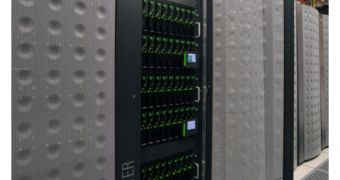Fujitsu announced earlier today that it has received a contract from the Kamioka Observatory, part of the University of Tokyo's Institute for Cosmic Ray Research, to build a system which uses neutrino observations to understand the origin of the universe.
The new system will primarily be comprised of a x86 cluster system consisting of 142 Primergy BX922 S2 blade servers, with 284 Intel Xeon 5600 processors for delivering a total of 1,704 computing cores.
For storage duty, the blade servers will be paired together with a system made up of Fujitsu Eternus DX80 S2 disk storage servers and two Eternus LT270 tape libraries, with a total of 3.1 petabytes of storage capacity, roughly 4.4 times that of its predecessor.
Tape or disk storage can be selected depending on the purpose, helping to make operations more efficient.
In addition, the Fujitsu FEFS scalable-file system software can handle high-volume simultaneous accesses from the computation server's parallelized 284 processors and 1,704 computing cores at roughly 7 times the transfer speed of its predecessor.
Finally, while overall system performance has been enhanced, power consumption has been reduced by roughly 22% compared to the previous system the University utilized.
"The increased CPU and memory performance of the new system will reduce the time needed to analyze neutrinos arriving from supernova explosions and increase detection sensitivity, allowing us to make more precise measurements than ever before,” said Yoshinari Hayato, Associate Professor, ICRR, University of Tokyo.
“The greater computing power also promises to increase the efficiency and degree of detail in research on differences in oscillations between neutrinos and anti-neutrinos, which are based on atmospheric neutrino data.
“The increase in disk capacity will improve the capture and analysis of low-energy solar neutrino data,” concluded Prof. Hayato.
The new experiment-analysis system built by Fujitsu is scheduled to go online in March of 2012.

 14 DAY TRIAL //
14 DAY TRIAL //